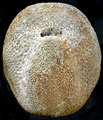The Echinoid Directory
Prenaster Desor, 1853, p. 279
[= Saviniaster Lambert, 1911, p. 33, type species S. miqueli Lambert, 1911; = Parabrissus Bittner, 1880, objective]
| Diagnostic Features |
|
|---|---|
| Distribution | Lower Eocene to Recent, Europe, North Africa, Madagascar, Australia, Japan. |
| Name gender | masculine |
| Type | Prenaster alpinus Desor, 1853, p. 279; by original designation. |
| Species Included |
|
| Classification and/or Status |
|
| Remarks |
|





